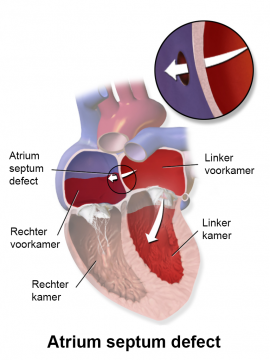Congenital heart defect
Symptoms and causes
Symptoms and causesWhat is it?
Congenital heart defects are the result of a disturbance in the development of the heart during the earliest embryonic period (2 to 12 weeks after conception). Some congenital heart defects can be hidden by the body for a long time and therefore only cause symptoms later in life.
Congenital heart defects can occur with a syndrome (e.g. Down syndrome), but can also occur on their own.
The following congenital heart defects are the most common:
Bicuspid aortic valve
This is a valve between the heart and large body artery or aorta that has two valve flap instead of three. This increases the risk of rapid wear and tear, valve leaks and/or valve constriction. There is also an increased risk of an aortic aneurysm.
Patent foramen ovale
This is a remaining tunnel that connects the right and left atria. This passage is crucial in the baby's developmental phase and closes after birth. This closureis incomplete in approximately 25% of people. On rare occasions, this passage can allow a clot to pass through, which can lead to a stroke.

- Atrium septum defect
This is a gap between the two atria. See figure.
- Ventricular septum defect
This is a gap between the two chambers (ventricles). This abnormal connection causes overtaxation of the heart and can weaken it. This is how heart failure develops.
- Coarctatio
Coarctation refers to the narrowing or constriction of the body’s main artery (the aorta).
Symptoms
Usually, congenital heart diseases are detected and treated during childhood. At a later age, the only symptom a physician can hear is a heart 'murmur'.
Other common symptoms include:
- fatigue
- shortness of breath
- heart palpitations
- fainting
- heart rhythm disturbances
Diagnosis and treatment
Diagnosis and treatmentHow is the diagnosis determined?
- Electrocardiogram
- Ultrasound via the chest (transthoracic ultrasound)
- Ultrasound through the oesophagus (transoesophageal ultrasound)
- CT or MRI of the heart
- Diagnostic cardiac catheterisation
Treatment
There are both surgical and non-surgical techniques for the treatment of a congenital heart defect. Because congenital defects are different in almost every patient, individual treatment is always ‘customised'. It is obviously best for you to be guided by the attending cardiologist.
A commonly used non-surgical technique for closing 'holes' is the placement of an 'umbrella'. The defect is approached with a catheter, after which a split disc can be unfolded to close the hole.
Treatment centres and specialisations
Treatment centres and specialisations
Latest publication date: 14/05/2024
Supervising author: Dr Provenier Frank




